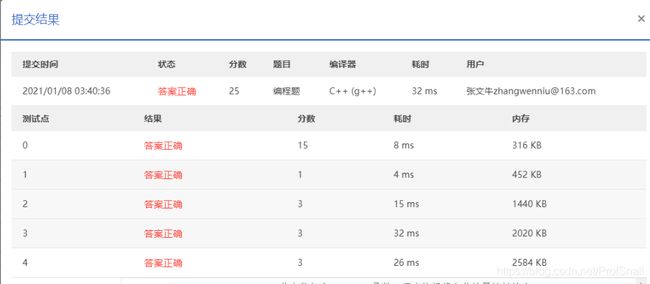1095 解码PAT准考证 (25分)击破测试点3、4,50ms内通关
1095 解码PAT准考证 (25分)测试点34用时低于35ms
- 前言
- 一、题目简介
- 二、原题内容
-
- 1. 设定
- 2. 输入格式
- 3. 输出格式
- 三、题目分析
-
- 1. 要求1分析
- 2. 要求2分析
- 3. 要求3分析
- 4. 完整代码
- 总结
前言
肝了四五天,肝完了PAT乙级真题。1095 解码PAT准考证 (25分)作为PAT乙级的最后一道题,题目的复杂程度相较前面的题目有所提升,对时间的把控要求也更高,基本上代表了乙级真题里的最高难度,属于毕业题。如果采用复杂冗长的代码和非缓存式的计算结构,很有可能使得此题的最后两个测试点因为超时而无法通过。附上本文代码,平均用时,测试点3、4用时30-50ms以内,测试点0、1用时5ms上下,测试点2用时14ms上下。
提示:以下是本篇文章正文内容,下面案例可供参考
一、题目简介
给定准考证号及考试成绩。
要求1:根据级别,输出准考证号和分数。(输出多行)
要求2:根据考场号,输出人数和总分.(输出单行)
要求3:根据日期,输出考场号和总人数.(输出多行)
二、原题内容
1. 设定
PAT 准考证号由 4 部分组成:
- 第 1 位是级别,即 T 代表顶级;A 代表甲级;B 代表乙级;
- 第 2~4 位是考场编号,范围从 101 到 999;
- 第 5~10位是考试日期,格式为年、月、日顺次各占 2 位;
- 最后 11~13 位是考生编号,范围从 000 到 999。
现给定一系列考生的准考证号和他们的成绩,请你按照要求输出各种统计信息。
2. 输入格式
输入首先在一行中给出两个正整数 N(≤10000 )和 M(≤100),分别为考生人数和统计要求的个数。
接下来 N 行,每行给出一个考生的准考证号和其分数(在区间 [0,100] 内的整数),其间以空格分隔。
考生信息之后,再给出 M 行,每行给出一个统计要求,格式为:类型 指令,其中
- 类型 为 1 表示要求按分数非升序输出某个指定级别的考生的成绩,对应的 指令 则给出代表指定级别的字母;
- 类型 为 2 表示要求将某指定考场的考生人数和总分统计输出,对应的 指令 则给出指定考场的编号;
- 类型 为 3 表示要求将某指定日期的考生人数分考场统计输出,对应的 指令 则给出指定日期,格式与准考证上日期相同。
3. 输出格式
对每项统计要求,首先在一行中输出 Case #: 要求,其中 # 是该项要求的编号,从 1 开始;要求 即复制输入给出的要求。随后输出相应的统计结果:
- 类型 为 1 的指令,输出格式与输入的考生信息格式相同,即 准考证号 成绩。对于分数并列的考生,按其准考证号的字典序递增输出(题目保证无重复准考证号);
- 类型 为 2 的指令,按 人数 总分 的格式输出;
- 类型 为 3 的指令,输出按人数非递增顺序,格式为 考场编号 总人数。若人数并列则按考场编号递增顺序输出。
如果查询结果为空,则输出 NA。
输入样例:
8 4
B123180908127 99
B102180908003 86
A112180318002 98
T107150310127 62
A107180908108 100
T123180908010 78
B112160918035 88
A107180908021 98
1 A
2 107
3 180908
2 999
输出样例:
Case 1: 1 A
A107180908108 100
A107180908021 98
A112180318002 98
Case 2: 2 107
3 260
Case 3: 3 180908
107 2
123 2
102 1
Case 4: 2 999
NA
三、题目分析
1. 要求1分析
类型 为 1 表示要求按分数非升序输出某个指定级别的考生的成绩,对应的 指令 则给出代表指定级别的字母;
即:给定级别(ID[0]),输出排序后的编号(ID)和得分(score)
定义。给定结构体:
struct Info {
string id; //名字
int score; //得分
};
定义。给定排序方法:
int cmp(Info a, Info b) {
return a.score == b.score ? a.id < b.id : a.score > b.score;
}
处理输入。
使用数组存储各个级别对应的个人信息结构体。‘A’, ‘B’, 'T’各自对应一组结构体集合。由于map的特性,如果没有对应的级别,也不会额外创建这组结构体。
特别说明的是,只有case1需要提前全部计算完毕三种组合,以便于查询过程中随用随取。其余Case2,Case3,输入对应的所有组合数量多,如果提前全部计算,查询数目远远小于计算的数目,会导致大量不必要的开销。
vector<Info> vInfo;
map<char, vector<Info> >mci;
for (int i = 0; i < N; i++) {
Info info;
cin >> info.id;
scanf("%d", &info.score);
vInfo.push_back(info);
mci[info.id[0]].push_back(info);
}
for (map<char, vector<Info> >::iterator it = mci.begin(); it != mci.end(); it++) {
sort(mci[it->first].begin(), mci[it->first].end(), cmp);
}
处理输出。map类型的mci.count(char)==1意义是判断该关键字是否在字典中出现过,相当于mci.find(char)!=mci.end()。
case 1: {
scanf("%c", &c);
printf("Case %d: %d %c\n", i + 1, choice, c);
if (mci.count(c)==1) {
for (int i = 0; i < mci[c].size(); i++) {
cout << mci[c][i].id;
printf(" %d\n", mci[c][i].score);
}
}
else {
printf("NA\n");
}
break;
}
2. 要求2分析
- 类型 为 2 表示要求将某指定考场的考生人数和总分统计输出,对应的 指令 则给出指定考场的编号;
即:给定考场号(ID[1-3]),输出该考场号对应的总人数(num)和总得分(score)。
定义。给定结构体:
struct case2 {
int num, score;
};
// 定义map2,将考场号(string)类型,转化为case2类型。用于缓存处理。
map<string, case2> mp2;
如果没有缓存处理,代码是如下结构:
case 2: {
cin >> placeId;
printf("Case %d: %d ", i + 1, choice);
cout << placeId << endl;
score = num = 0;
for(int i = 0; i < N; i++){
if (vInfo[i].id.substr(1, 3) == placeId) {
num++;
score += vInfo[i].score;
}
}
if (num > 0) {
printf("%d %d\n", num, score);
}
else printf("NA\n");
break;
}
这一串代码很简洁,把要处理的任务都处理掉了。每次查询都会遍历一遍所有考生的信息,检查N个考生的考场号是否与待查询的考场号相符。
但是这样做问题很明显:如果接下来100条查询都和第一次的查询一样,都在查询某一个场次,则会访问100*N次,时间复杂度为O(MN)。而如果将第一次查询的结果保存在一个字典中,下一次查询时候就可以直接读出,访问次数为N+100次,时间复杂度降为O(M+N)。
每次查询时,首先看该记录是否已经被缓存,如果已经被缓存,则访问并退出;否则,逐个检查N个考生的考场号,并将结果进行缓存。缓存后的代码如下。
case 2: {
cin >> placeId;
printf("Case %d: %d ", i + 1, choice);
cout << placeId << endl;
if (mp2.count(placeId)) {
printf("%d %d\n", mp2[placeId].num, mp2[placeId].score);
break;
}
score = num = 0;
for(int i = 0; i < N; i++){
if (vInfo[i].id.substr(1, 3) == placeId) {
num++;
score += vInfo[i].score;
}
}
if (num > 0) {
printf("%d %d\n", num, score);
case2 cs;
cs.num = num;
cs.score = score;
mp2[placeId] = cs;
}
else printf("NA\n");
break;
}
3. 要求3分析
类型 为 3 表示要求将某指定日期的考生人数分考场统计输出,对应的 指令 则给出指定日期,格式与准考证上日期相同。
即:给定日期(ID[4-9]),输出排序后的考场号(ID[1-3])和总人数(num)
复用前文的结构体,因为要求3的输出内容也是一个string和int:
struct Info {
string id; //考场号
int score; //总人数
};
//用于缓存的字典。
map<string, vector<Info> > mp3;
如果没有缓存处理,代码是如下结构:
case 3: {
cin >> date;
printf("Case %d: %d ", i + 1, choice);
cout << date << endl;
//mp用于存放给定日期下,考场编号到该考场考生人数的映射。
map<string, int> mp;
//逐个比对日期信息
for (int i = 0; i < N; i++) {
//日期信息相符
if (vInfo[i].id.substr(4, 6) == date) {
placeId = vInfo[i].id.substr(1, 3);
//计算当日每个考场内的学生总数。
if (mp.count(placeId)) {
mp[placeId]++;
}
else {
mp[placeId] = 1;
}
}
}
//当日没有分配考场
if (mp.size() == 0) {
printf("NA\n");
break;
}
//只有形成了结构体的向量(数组),才能方便进行排序
vector<Info> dp;
Info temp;
for (map<string, int>::iterator it = mp.begin(); it != mp.end(); it++) {
//ID:考场编号。score:该考场内的考生
temp.id = it->first;
temp.score = it->second;
dp.push_back(temp);
}
//排序
sort(dp.begin(), dp.end(), cmp);
for (int i = 0; i < dp.size(); i++) {
cout << dp[i].id;
printf(" %d\n", dp[i].score);
}
break;
}
同理,是否采用缓存结构,也是数量级O(MN)到数量级O(M+N)的转换。已经在必要的步骤处做了注释。与上段代码增加的地方就是缓冲的内容。
case 3: {
cin >> date;
printf("Case %d: %d ", i + 1, choice);
cout << date << endl;
if (mp3.count(date)) {
if (mp3[date].size() == 0) {
printf("NA\n");
break;
}
for (int i = 0; i < mp3[date].size(); i++) {
cout << mp3[date][i].id;
printf(" %d\n", mp3[date][i].score);
}
break;
}
//mp用于存放给定日期下,考场编号到该考场考生人数的映射。
map<string, int> mp;
//逐个比对日期信息
for (int i = 0; i < N; i++) {
//日期信息相符
if (vInfo[i].id.substr(4, 6) == date) {
placeId = vInfo[i].id.substr(1, 3);
//计算当日每个考场内的学生总数。
if (mp.count(placeId)) {
mp[placeId]++;
}
else {
mp[placeId] = 1;
}
}
}
//当日没有分配考场
if (mp.size() == 0) {
printf("NA\n");
vector<Info> dp;
mp3[date] = dp;
break;
}
//只有形成了结构体的向量(数组),才能方便进行排序
vector<Info> dp;
Info temp;
for (map<string, int>::iterator it = mp.begin(); it != mp.end(); it++) {
//ID:考场编号。score:该考场内的考生总数。
temp.id = it->first;
temp.score = it->second;
dp.push_back(temp);
}
//排序
sort(dp.begin(), dp.end(), cmp);
for (int i = 0; i < dp.size(); i++) {
cout << dp[i].id;
printf(" %d\n", dp[i].score);
}
mp3[date] = dp;
break;
}
4. 完整代码
// 创作By:[email protected],转载请注明出处。
#include 总结
提示:注意第三问,要求在给定日期下的某考场,相当于是日期+考场(ID[1-9])作为总关键字进行统计。当心陷阱。以上就是今天要讲的内容,本文仅仅简单介绍了缓冲思想的应用。最后放上AC的截图,仅供大家参考。
